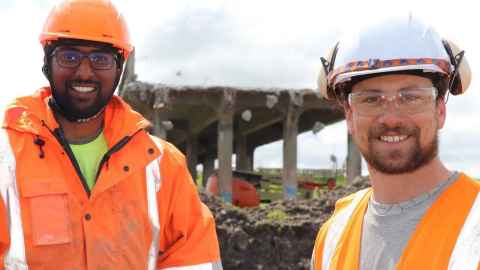Postgraduate studies in Earthquake Engineering offer career boost for industry professionals
25 November 2020
New Zealand’s unique geography has contributed to our world-renowned research and teaching capabilities in Earthquake Engineering.

Dr Lucas Hogan works in our Structures Testing Laboratory, where a shake table is among the equipment that PhD candidates and industry partners use to advance their understanding of how materials perform in extreme events. When asked recently about the overall trends that shape the way engineers think about New Zealand’s built environment, he cited earthquakes and seismic activity as a continual concern.
Earthquakes may be rare events, but they ask a lot of our existing infrastructure and the damage they cause is unique. Dr Hogan says it’s not just the amount of force involved in these events that makes them so destructive and so hard to build for, but the direction of those forces.
“People are quite good at understanding things that are pointing straight up and down because we have to deal with gravity all the time,” he begins. “So if you look at a tabletop, I can load up that table with weights and if you see the table start sagging then it’s clear I should take some load off it. What we're not so good at - just because we don't have the practice - is when things push sideways. Sure, wind does that a little bit, but then earthquakes do that in a really big way, and trying to account for that [in a structure] is a real challenge.”
This understanding of seismic behaviour and its effects on structures is useful for professionals no matter where they’re working. Dr Hogan notes that structural engineers working in New Zealand in particular would never be able to escape earthquake resilience as a concern, but the concerns would be the same for engineers living in another country and being asked to consult on projects in areas with higher rates of seismic activity.
“You can't practice in New Zealand and get away from the earthquake problem, even up in Northland which has really low seismicity, you still have to contend with it. You might be living in Auckland, working in Auckland and have a project somewhere else where you do have to be able to deal with this.”
Dr Hogan describes Earthquake Engineering as a field of study that enhances people’s understanding of fundamental engineering knowledge and puts those principles into a context where they’re (potentially) put through extreme tests.
“The nice thing about earthquake engineering is that- because it is such a violent event for a structure to try to withstand - the principles you learn from all of that translate to everything else,” he explains. “An analogy is the human body. Where do things tend to break down on us? In really violent impacts you might break a bone, but mostly you're wearing out joints, you're going to tear ligaments, so it's all the connections that tend to be the more vulnerable parts and it's the same thing with the building. Rarely do you have a building collapse because the beams or the columns of the walls were undersized. It's mostly because the connection was poorly thought out. So we look at how these buildings move in an earthquake and what the mathematics are behind that.”
For professionals looking to pursue postgraduate study in the field, Dr Hogan recommends the dedicated masters courses that align with the direction that the industry is going in. It’s an opportunity for a working professional to learn from experts and prepare for career growth.
“So we've had our Masters in earthquake engineering, which has been going on for two or three years now. We've got some very good courses there, and these are really - in terms of a cost-benefit for an individual student - probably the best thing they can do if they want to do more than just the generic new and straightforward regular buildings.”
“There's a real benefit - particularly the way the profession is going - that if you want to do these higher-end computer analyses - which are really important for understanding how something behaves in an earthquake - taking these courses is a really efficient way to learn. It's very difficult to learn that stuff on your own.”
Alongside the Masters, there's a Postgraduate Certificate options that offers part-time study and block courses which make it ideal for industry professionals looking for flexible learning options. It's comprised of four courses from the Masters, and can be completed in as short as one semester.